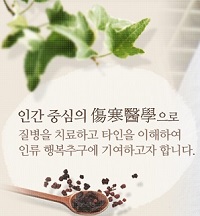 ISSN : 2287-8696
ISSN : 2287-8696
A Case Report of migraine and a case report of restless legs syndrome treated with Osuyu-tang based on Shanghanlun Provisions
Abstract
Objective : This study was intended to evaluate if treatment with Osuyu-Tang following the disease pattern identification diagnostic system based on Shanghanlun provisions (DPIDS) worked analyzing the progress of patients with migraine and restless legs syndrome and to reinterpret the provision of 309 Soyinbing Osuyu-Tang based on the analysis of whether it worked. Methods : Two cases treated with Soyinbing Osuyu-Tang were analyzed using DPIDS. The migraine and restless legs syndrome in both cases were evaluated using the migraine disability assessment (MIDAS) and the Korean versions of the international restless legs scale (K-IRLS), respectively. Results : In the first case, during 45 days of treatment, the MIDAS decreased from 10 days to 3 days. In the second case, during 30 days of treatment, the K-IRLS decreased from 30 to 9. In both cases, Soyinbing was associated with the disease, although the activity was less; and Leng (冷) was associated with numbness in the kneeling position. Conclusions : It was confirmed that treatment with Osuyu-Tang was effective against migraine and restless legs syndrome and that Leng could be associated with numbness in the kneeling position. The etymological analysis of the Shanghanlun characters suggested the possibility of further clarifying the clinical significance and interpretation of Shanghanlun.
- keywords
- Soyinbing, Osuyu-Tang, Leng (冷), Shanghanlun, disease pattern identification diagnostic system based on Shanghanlun provisions (DPIDS), Herbal medicine
Reference
1. Yamada K. How did traditional Chinese medicine start. Seoul publishing company science books. 2002:155,170-1.
2. Park KM, Choi SH. The comparative study of 『Sanghanron』and 『hwangjenaegyeong』through historical study on 『Gangpyung Sanghanron』. J. Korean Medical Classics. 1995;9:263-300.
3. Lee SJ, Lim JE. A diagnostic system and clinical application based on Shanghanlun six meridian patterns and provisions. Seoul:KMediACs publishing house. 2013.
4. Park SK, Kim YK, Oh MS. Herbal formula science. Yeonglimsa. 2010:163-4.
5. Shin JM, Hyun JY. A case report of Soeumbyeong acne vulgaris patient treated with Osuyu-Tang. Journal of Korean medical association of clinical sanghan-geumgwe. 2013;5(1):93-100.
6. Yun SM, Im EK. A case report of atopic dematitis treated by Osuyu-Tang based on Shanghanlun provisions. Journal of Korean medical association of clinical sanghan-geum -gwe. 2013;5(1):85-92.
7. Lee SJ, Seo HA, Lee SI. A case report of psoriasis treated by Osuyu-Tang based on Shanghanlun. Journal of herbal formula science. 2016;24(1):53-61.
8. Hur HS, Jung SY, Shim WS, Kim GS, Kim KM, Kim YK. A case of vascular headache treated with Osuyu-Tang. J Int Korean Med. 2015:287-91.
9. Lee SI, Cho HR. Comparison of Shanghanlun. Seoul:KMediACs publishing house. 2015:23,32,37,209,214.
10. Lee HS, Chung CS, Song HJ, Park HS. The reliability and validity of the MIDAS questionnaire for Korean migraine sufferers. J Korean Neurol Assoc. 2000;18(3):287-91.
11. Yang JG, Kim DH, Lee JH, Park KH, Jung KY, Shin WC, Cho YW. The reliability and validity of the Korean versions of the international restless legs scale and the restless legs syndrome quality of life questionnaire. J Korean Neurol Assoc. 2010;28(4):263-69.
12. Ootsuka K. Shanghanlun explanation. Euibang publishing company. 2004:21-55.
13. Ha YS. Hanjaeowonsajeon. 3Publication. 2014:209,273,324,363,585,692.
14. Liao WH. The tree of chinese character. Munhakdongne publication. 2015:87,88,237.
15. Chinese etymology. 令. retrieved 2019 Dec 18. Available URL:https://hanziyuan.net/#home
- Downloaded
- Viewed
- 0KCI Citations
- 0WOS Citations

